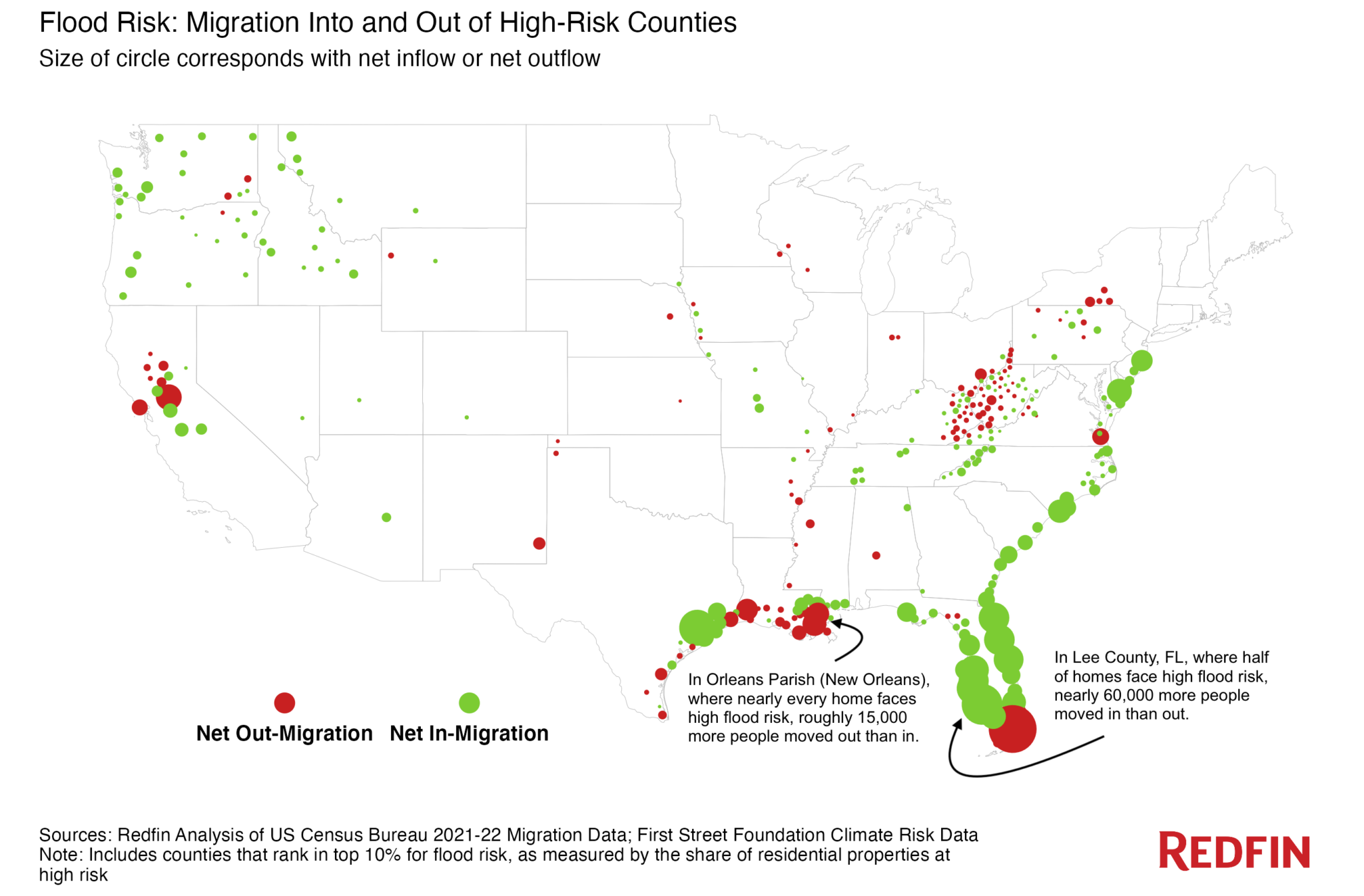Climate risk disclosure at property level significantly influences housing search and buying dynamics
Climate change can be considered a large and pervasive threat to property markets across the world. Yet, there is an increasing body of evidence suggesting that individuals are largely unaware of the property risks associated with climate change, like flooding or wildfires. The consequence according to a recent study published in Nature, is that residential properties exposed to flood risk are overvalued by approximately $200 billion. This is worrisome given that the median U.S. households had 68% of their wealth stored in their primary residence. Clearly, for individuals to engage in adaptive behavioral measures, they must first become aware of the current and future climate risks.
A group of researchers recently conducted a field experiment looking specifically at the impact of climate risk disclosure on housing search and buying dynamics. Alexander Carlo, Doctoral Candidate in Real Estate Finance at the School of Business and Economics, Maastricht University, discusses the findings of this study and highlights the relevance for institutional investors in the real estate market.
First Street Foundation: The first step toward change is awareness
In order to study the impact of climate risk disclosure on housing search and buying dynamics, a group of researchers conducted a nationwide field experiment encompassing $17.5 million users of the brokerage service Redfin in the U.S. housing market. From this sample of the population, property-level climate risk information was randomly disclosed to some while others did not receive such information. Figure 1 shows the visual experience for treated individuals who received climate risk information of a browsed property. The property level climate risk data was provided by First Street Foundation, a non-profit with the mission to make climate risk accessible, easy to understand, and actionable for individuals, governments, and industry.
Figure 1 depicts the type of environmental risk disclosure that realtor.com provides on their platform today.

Furthermore, the authors augment the Redfin data with market data on all U.S. property transactions. This setup allows the researchers to study the impact of climate disclosure on housing search and pricing dynamics.
Housing search and buying dynamics are significantly impacted
The findings are promising. For housing search dynamics, the results suggest that flood risk disclosure made individuals more likely to browse properties with lower flood risk and that individuals were willing to trade-off property characteristics (e.g., neighborhood amenities) to avoid climate risk disamenity. Interestingly, the results were more pronounced for individuals who were searching for houses outside of the zip code of their current residence. This higher sensitivity to flood risk information reflects their limited local information and knowledge.
As for the pricing dynamics, the results suggest that the more flood-prone homes that had a higher percentage of treated users (i.e., climate risk information was known to a relatively large change of the buyers), experienced a decrease in valuation by up to $7000. In aggregate, this information reduced the prices of these high flood risk properties by $57 million.
Institutional investors beware, homeowners are voting with their feet
The implications for institutional investors are numerous. First, the findings of the study suggest that homeowners who are more aware of both current and future climate risks are more likely to vote with their feet to avoid climate risk disamenities (i.e., sort into different neighborhoods, counties or even states). Yet, the evidence until recently is that more people are moving into than out of disaster-prone places (Figure 2 and 3). Redfin claims that the increase in the prevalence of remote work and relatively lower housing costs during the pandemic era incentivize people to move away from expensive (and low-risk) cities to cheaper (and high-risk) areas[1].
Figure 2

Figure 3

The question is, for how long will people keep moving to these areas? I believe that as people become more aware of climate risk, and the housing costs keep increasing, people will start to move away. Home insurance plays a key role in this discussion. The cost of house insurance is going through the roof as insurance companies are hiking up premiums in order to cover the increasing amount of climate-catastrophe-related damages. Some insurance companies have even stopped issuing new policies in certain high-risk areas[2].
Take as an example the state of Louisiana, still reeling from four hurricanes in 2020 and 2021 which caused a total of $3 billion in damages. According to Census data, it is among the top three states which lost the greatest percentage of their populations between 2021 and 2022. Of course, there are likely various factors influencing this trend, however, I am certain the hurricane damage and the accompanying increase in property insurance costs are key drivers. Lastly, this highlights the importance of using reliable and accurate climate risk data in the investible real estate market. In the US, there are maps provided by FEMA that indicate areas exposed to high flood risk. However, various studies suggest that the maps are extremely outdated and inaccurate. That was also highlighted in this study, as the price decreases were observed for properties that were not considered risky by FEMA or not on the waterfront but were identified as risky by First Street Foundation.
Call upon investors to collaborate and achieve real-world impact
GREEN is a not-for-profit collaborative engagement initiative for institutional investors, focusing on reducing climate risk in the real estate industry. GREEN members acknowledge the importance of collaboration to initiate change and maximize impact. We, therefore, call upon other institutional investors to join GREEN and work together towards a Paris-aligned real estate sector. Check the investor statement for more information.
Disclaimer
The views presented in this article reflect the views of the GREEN Secretariat but do not necessarily represent those of the individual GREEN members.
[1] https://www.redfin.com/news/climate-migration-real-estate-2023/
[2] https://green-engagement.org/cost-climate-risk-us-real-estate-markets/






